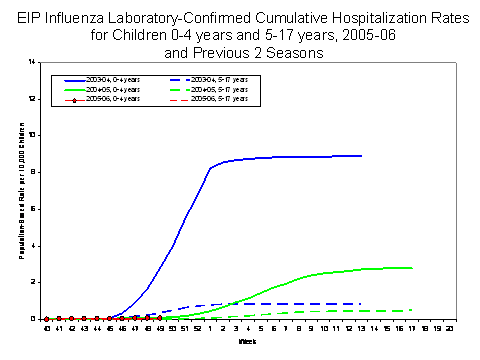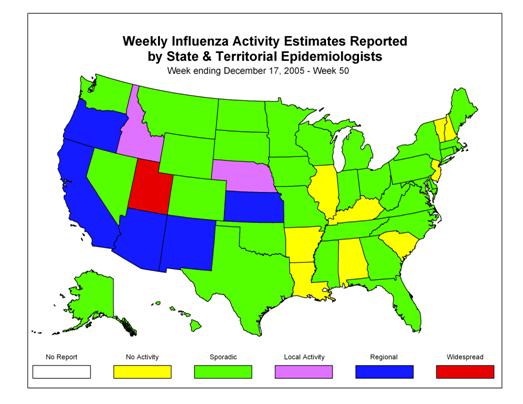Error processing SSI file
Error processing SSI file
Weekly Report: Influenza Summary Update
Week ending December 17, 2005-Week 50
Error processing SSI fileSynopsis:
During week 50 (December 11 ?December 17, 2005)*, influenza activity continued to increase mostly in the southwestern United States. One hundred sixty-nine (8.9%) specimens tested by U.S. World Health Organization (WHO) and National Respiratory and Enteric Virus Surveillance System (NREVSS) collaborating laboratories were positive for influenza. The proportion of patient visits to sentinel providers for influenza-like illness (ILI) was above the national baseline. The proportion of deaths attributed to pneumonia and influenza was below the baseline level. One state reported widespread influenza activity; 5 states reported regional influenza activity; 2 states reported local influenza activity; 33 states, New York City and the District of Columbia reported sporadic influenza activity; and 9 states reported no influenza activity.
Laboratory Surveillance*:
During week 50, WHO and NREVSS laboratories reported 1,906 specimens tested for influenza viruses and 169 (8.9%) were positive. Of these, 123 were influenza A (H3N2) viruses, 42 were influenza A viruses that were not subtyped, and 4 were influenza B viruses.
Since October 2, WHO and NREVSS laboratories have tested a total of 26,006 specimens for influenza viruses and 497 (1.9%) were positive. Among the 497 influenza viruses, 463 (93.2%) were influenza A viruses and 34 (6.8%) were influenza B viruses. Three hundred and three (65.4%) of the 463 influenza A viruses have been subtyped; 299 (98.7%) were influenza A (H3N2) viruses and 4 (1.3%) were influenza A (H1N1) viruses. Thirty-five states from all surveillance regions** have reported laboratory-confirmed influenza this season. One hundred eighty-seven (37.6%) of the 497 isolates have been reported by the Mountain region and 158 (31.8%) were from the Pacific region.
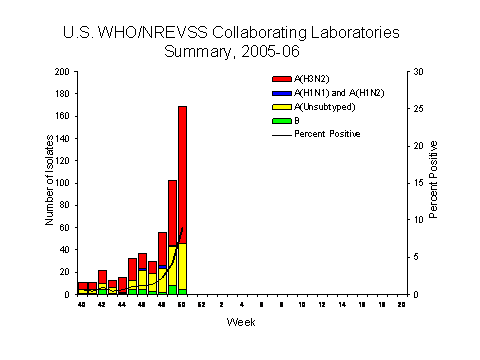
Antigenic Characterization:
CDC has antigenically characterized 26 influenza viruses [23 influenza A (H3N2) and 3 influenza B viruses] collected by U.S. laboratories since October 1, 2005. Of the 23 influenza A (H3N2) viruses, 21 were characterized as A/California/07/2004-like, which is the influenza A (H3N2) component recommended for the 2005-06 influenza vaccine, and 2 showed reduced titers with antisera produced against A/Califonia/07/2004. Influenza B viruses currently circulating can be divided into two antigenically distinct lineages represented by B/Yamagata/16/88 and B/Victoria/2/87 viruses. Two of the influenza B viruses isolated belong to the B/Yamagata lineage. One was similar to B/Shanghai/361/2002, the recommended influenza B component for the 2005-06 influenza vaccine, and one was characterized as B/Florida/07/2004-like. B/Florida/07/2004 is a minor antigenic variant of B/Shanghai/361/2002. The other influenza B virus was identified as belonging to the B/Victoria lineage.
Pneumonia and Influenza (P&I) Mortality Surveillance*:
During week 50, 6.5% of all deaths reported by the vital statistics offices of 122 U.S. cities were reported as due to pneumonia or influenza. This percentage is below the epidemic threshold of 7.7% for week 50.
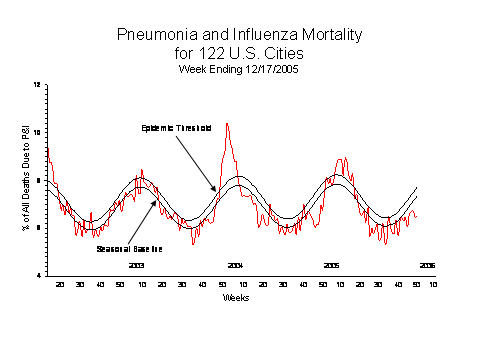
Influenza-Associated Pediatric Mortality*:
No influenza-associated pediatric deaths were reported for week 50. Since October 2, 2005, CDC has received reports of four influenza-associated pediatric deaths, two of which occurred during the 2004-05 influenza season.
Influenza-Associated Pediatric Hospitalizations*:
Laboratory-confirmed influenza-associated pediatric hospitalizations are monitored in two population-based surveillance networks? the Emerging Infections Program (EIP) and the New Vaccine Surveillance Network (NVSN). During October 1 ?December 10, 2005, the preliminary influenza-associated hospitalization rate for children 0-4 years old reported by the EIP was 0.07 per 10,000. The EIP also monitors hospitalizations in children 5-17 years old. There were no influenza-associated hospitalizations for this age group reported during this period. The overall hospitalization rate reported by the EIP for children aged 0-17 years was 0.03 per 10,000. During October 30 ?December 10, 2005, there were no laboratory-confirmed influenza-associated hospitalizations for children 0-4 years old in the NVSN. EIP and NVSN hospitalization rate estimates are preliminary and may change as data continue to be collected.
Influenza-like Illness Surveillance*:
During week 50, 2.6%*** of patient visits to U.S. sentinel providers were due to ILI. This percentage is above the national baseline of 2.2%. The percentage of visits for ILI ranged from 0.6% in the West North Central region to 5.3% in the Pacific region**. Due to wide variability in regional level data, it is not appropriate to apply the national baseline to regional level data.
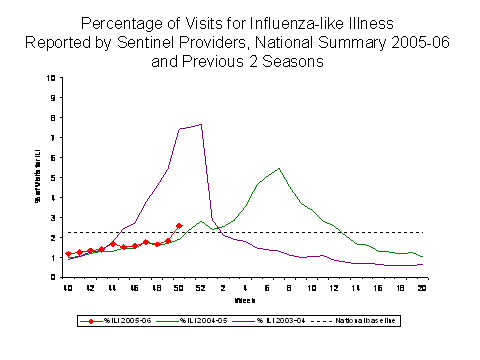
View
Chart Data
| View Full Screen
Influenza Activity as Assessed by State and Territorial Epidemiologists*:
During week 50, Utah reported widespread influenza activity and Arizona, California, Kansas, New Mexico, and Oregon reported regional influenza activity. Two states (Idaho and Nebraska) reported local influenza activity. Thirty-three states (Alaska, Colorado, Connecticut, Delaware, Florida, Georgia, Hawaii, Indiana, Iowa, Maine, Maryland, Massachusetts, Michigan, Minnesota, Mississippi, Missouri, Montana, Nevada, New York, North Carolina, North Dakota, Ohio, Oklahoma, Pennsylvania, Rhode Island, South Dakota, Tennessee, Texas, Virginia, Washington, West Virginia, Wisconsin, and Wyoming), New York City and the District of Columbia reported sporadic influenza activity. Nine states reported no influenza activity.
--------------------------------------------------------------------------------
Report prepared December 22, 2005
Error processing SSI file